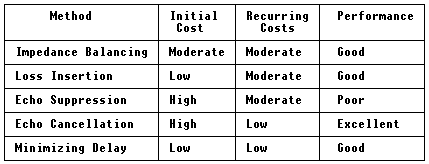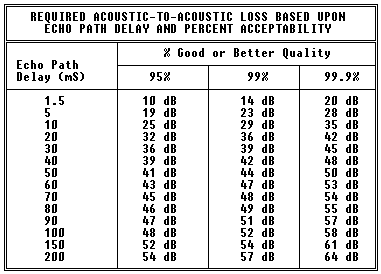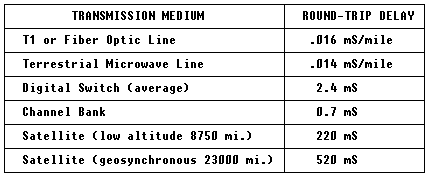| RETURN | Voice Networking |
Echo Control Techniques
There are four methods of controlling Talker Echo:
(A) Careful balance of impedance.
(B) Insertion of loss into the 4-wire path.
(C) The installation of echo suppressors or cancelers.
(D) Minimizing Delay.
Of these methods, the first three (‘A’ through ‘C’ above) are also effective in controlling Listener Echo as well.
A comparison of these methods is provided by the following table:

Impedance Balancing
Each hybrid transformer is equipped with a balancing network that is designed to minimize impedance mismatches. The amount of reflected energy in the hybrid transformer is measured in terms of Return Loss. As noted in ‘Notes On The Network’ and CCITT G.100, Return loss can be expressed in dB by the following formula:
| Zn + Zl |
- Return Loss = 20 Log | ------- | dB
10 | Zn - Zl |
Zn = impedance of the balancing network
Zl = impedance looking into the 2-wire circuit.
Since Return Loss is also a function of frequency, Echo Return Loss (ERL) values are used, since ERL is a weighted average of the Return Losses over a band of frequencies from 500 to 2500 Hz.
Since the 2-wire path usually varies from connection to connection, as different telephone 2-wire paths are used. It is because of this fact that the hybrid balancing networks are often referred to as “Compromise Balancing” networks.
Loss Insertion
The introduction of loss into the 4-wire circuit is also an effective method for echo control. Inserted loss appears once in the Primary Signal Path and twice in the Talker and Listener Echo Paths.
As a general rule-of-thumb, as circuit delays increase, inserted loss should also increase. The relationship between delay, loss, and perceived voice quality is discussed further on in this document.
Loss insertion within a voice network is sometimes referred to as a Loss Plan and should not be implemented without careful consideration. An ideal loss plan should provide a level of loss that is close to the optimal value for all voice circuit connections. Types of Loss Plans are discussed further on in other documents. IF THE LOSS IS NOT KNOWN, IT IS SUGGESTED THAT A FIXED AMOUNT BE INSERTED ON THE ANALOG TRUNK FACILITY.
Echo Suppression/Cancellation
Echo Suppressors and Cancelers can often be used to control Talker and Listener echo problems.
Echo Suppressors
Echo Suppressors operate such that when the suppressor detects Talker energy in the Primary Signal Path, it inserts a large amount of loss into the return path. Most echo suppressors are installed at the ‘far-end’ of the circuit; that is to say, that when the local talker is active, the echo suppression takes place at the far-end of the circuit.
Echo Suppressors do a fairly good job but do have some serious limitations, particularly when both talkers are active at the same time (Double-Talk). During double-talk scenarious, only minimal attenuation is offered. This can result in unsatisfactory speech quality, particularly on circuits with very long delays.
The switching between (to and from) the suppression and double-talk modes can also result in the ‘clipping’ of speech signals. Furthermore, in noisy environments, the suppression of the far-end signal may result in a dead set phenomenon, since the background noise from the far-end will be suppressed when the local talker is active.
Echo suppressors will typically implement a disable function upon detection of a 2100 Hz tone followed by continual speech energy, or under manual control. The tone disable signal must be 2100 Hz +/- 21 Hz (2079 Hz to 2121 Hz) at a level of -12 +/- 6 dBM0, as specified in CCITT V.21. The suppressor should be disabled when the disable tone is detected at levels between 0 and -31 dBM0 for 300 +/- 100 mS. The echo suppressor disable should not release for dropouts less than 100 mS.
CCITT Recommendation G.161 describes echo suppressor requirements. Note that this specification is not included in later CCITT books (G.161 is included in the 1977 Orange book). Additional requirements are detailed in CCITT G.164.
Echo Cancelers
Echo Cancelers are capable of performing a better job than echo suppressors in either analog or digital networks. Echo Canceler requirements are detailed in CCITT Recommendation G.165.
Cancellers are always installed in the far-end of the circuit to cancel local echo. When the far-end canceller detects incoming speech from the local talker, a period known as ‘convergence’ starts.
During convergence, the far-end canceler will ‘take a picture’ (Echo Model) of the incoming signal from the local talker, stores it, and then outputs the signal to the local circuit. The amount of storage (and indirectly; processing power) required depends upon the End-Path Delay (Echo Tail Length). CCITT G.165 does not specifically recommend any End-Path Delay requirements but, rather, leaves this value up to the manufacturer. If the amount of storage is too small, adequate synthesis cannot be achieved for all echo paths. If the amount of storage is too high, unused locations can result in excessive noise. Additionally, if the impulse response of the echo canceler’s path model is largely different from the actual path response, the total returned echo can be higher than that resulting from the echo path itself!
Then, the canceler looks for a similar signal coming back in from the reflected energy (echo). THE INCOMING RETURNED ENERGY MUST BE AT LEAST 6 dB LOWER THAN THE OUTPUT ENERGY PER CCITT G.165 (ERL + TLP).
THE MAXIMUM AMOUNT OF TIME REQUIRED TO CONVERGE IS SPECIFIED WITHIN G.165 AS 500 mS (1/2 Second). DURING THIS TIME, THE LOCAL TALKER CAN HEAR ECHO. THE AMOUNT OF INFORMATION LOST OR GARBLED DURING THIS PROCESS IS DEPENDENT UPON THE LANGUAGE CHARACTERISTICS OF BOTH TALKERS.
Once convergence has been achieved, the echo canceler begins to subtract the output signal from the incoming signal. This subtraction process will continue until the local talker (at the other end of the 4-wire circuit) ceases to speak. When the local talker resumes speaking, the echo canceler will again re-converge. Note that during double-talk conditions the perceived quality of echo cancellation does not change significantly, although the echo canceler tends to ‘diverge’.
The echo cancellation process will typically result in what is referred to as ‘residual echo’. This occurs as a result of small signal distortions between the output and input waveforms. These distortions occur as a result of the output Digital to Analog (D/A) conversion as well as non-linear tail circuit properties that can be present on both the 4-wire and 2-wire loops. THE AMOUNT OF RESIDUAL ECHO IS MEASURED IN TERMS OF ‘ECHO RETURN LOSS ENHANCEMENT’ (ERLE); the difference in measured ERL between the active and inactive echo cancelation states.
To eliminate the residual echo, the echo canceler may optionally employ a ‘non-linear processor’ function. This is usually referred to as a ‘Center Clipper’. The Center Clipper operates by suppressing residual echo using attenuation. During double-talk, the Center Clippers are removed from the circuit. However, this functionality is what truly makes the echo canceler superior to that of the echo suppressor, since during double-talk, there is true echo cancellation, not limited suppression.
CCITT Recommendation G.165 also specifies the use of Tone Disabler circuits. The disable tone is specified as 2100 Hz with frequency characteristics as specified in G.164. The 2100 Hz tone is subjected to 180 degree phase reversals, as specified in CCITT V.25. The Tone Disabler circuit must recognize the disable signal at levels between -6 and -31 dBM0. Additionally, the maximum amount of time required to disable the canceller (operate time) is specified to be one second.
Minimizing Delay
Since Talker echo is also a function of circuit delay, the reduction of this delay can prove beneficial in the resolution of SOME echo problems. This is likely to be beneficial when PCM or ADPCM transmission is used. Analog facilities can be reviewed to see if rerouting can reduce the physical trunk length. Many transmission facility equipment (particular digital systems) can be programmed to reduced delays.
Low Bit Rate Voice (LBRV) systems employ algorithms that result in high processing delays. In such cases, echo cancellation techniques are almost always required.
NOTE THAT MINIMIZING DELAY DOES NOT DIRECTLY ADDRESS LISTENER ECHO PROBLEMS.
Echo Grade-Of-Service Modeling
The AT&T ‘Notes on the Network’, ‘Section 7’, include a model that can be used for echo prediction. This model is based upon Echo Path Delay (mS), Acoustic-to-Acoustic Echo Path Loss (dB), and the percentage of customers who will rate the configuration as being acceptable.
The acoustic-to-acoustic losses include the effects of the handsets (telephone sets) used, as well as the electrical losses in the circuit. The acoustic properties of the handset are based upon Transmit Loudness Objective Rating (TLOR) plus the Receive Loudness Objective Rating (RLOR). These losses typically average about four (4) dB for Type 500 telephone sets. Note that the Type 500 telephone set actually has a mean loss of 9 dB with a deviation of +/- 5 dB. Therefore, the smaller loss value (9 dB -5 dB) has been used to derive the 4 dB value. DIFFERENT PHONE SETS WILL HAVE DIFFERENT VALUES!
The following diagram has been extracted from the previous document (The talker echo path). The loss variables (TLOR, RLOR, L1, L2, L2′, RL1) have been added to it:

L1 = 2-Wire loss (Dependent upon the cabling distance from the telephone
to the PBX, typically close to 0 or 1 dB).
L2 = 4-Wire loss (Towards the remote end)
L2'= 4-Wire loss (Towards the local end)
RL1= Hybrid return loss
Thusly, the effective acoustic-to-acoustic loss can be determined using the formula TLOR + L1 + L2 + RL1 + L2′ + L1 + RLOR; or, for Type 500 handsets, 4 + (2 * L1) + L2 + RL1 + L2′.
The Echo Path Delay value includes all roundtrip circuit delays. In general, all transmission equipment processing delays can be obtained and it is possible to predict the local PBX loop delays. However, at time of installation, what is NOT KNOWN are the T1/E1 circuit delays. The T1/E1 circuit delays depend upon Carrier/PTT routing (circuit miles) as well as what equipment the Carrier/PTT has installed in the circuit (DACS, Switch, and Channel Bank frame buffering, etc.). A rough guess of the T1/E1 circuit delays can be achieved based upon circuit miles, but more precise information should be obtained from either the Carrier/PTT or through test efforts. Delay options are available for various test equipments, including the Phoenix 5500A test set, the Tekelec Chameleon 8000, as well as the Sage 930A, to name a few.
The following information has been derived from the ‘Notes on the Network’ and tabulated into the following chart.

- Type 500 telephone set characteristics (TLOR + RLOR = 4)
- No 2-Wire loss (L1)
- The 4-Wire loss is 6 dB in each direction (L2 and L2')
- The ERL is 11 dB (RL1)
Using the formula, 4 + (2 * L1) + L2 + RL1 + L2′, the Echo Path Loss is seen to be a value of 27. The Echo Path Delay must be kept to just below 10 mS to achieve a 99% user satisfaction rating, while 99.9% user satisfaction can be achieved by limiting delay to 5 mS.
IN GENERAL, THE 11 dB ERL VALUE AND THE 4 dB ACOUSTIC LOSS (TLOR + RLOR) ARE TYPICAL VALUES. ROLM AND NORTHERN TELECOM PBXs TYPICALLY OPERATE WITH ERLs OF ABOUT 11 dB, AS DO PROPERLY ADJUSTED TELLABS 2-WIRE/4-WIRE CONVERTERS. THEREFORE, THESE VALUES SHOULD BE USED FOR ECHO PREDICTION PURPOSES WHERE THE EXACT LOSSES ARE NOT IMMEDIATELY KNOWN.
NOTE THAT THE TALKER ECHO PATH DELAY IS DEPENDENT UPON THE LOCATION OF THE REMOTE TELEPHONE. THIS MUST BE TAKEN INTO ACCOUNT IF OFF-NET CALLS, OR TRANSFERED OFF-NET CALLS ARE PLACED.
T1/Datalink Delay Times
There are many test sets that are capable of performing T1 delay measurements. But if you don’t have such a test set, the following table provides some useful delay information:

VF Cable Delay Times
